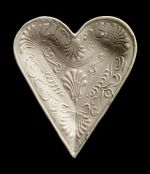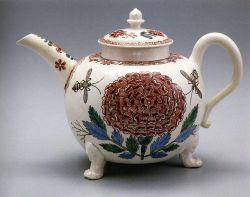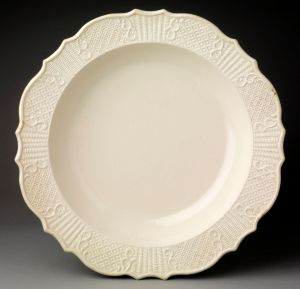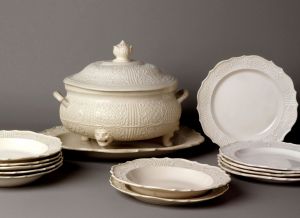|
As a young man Josiah Spode I worked for Thomas Whieldon, the most accomplished of Staffordshire's mid-18th century manufacturers. Archaeological discoveries on the site of Whieldon’s factory show that Spode would have been familiar with all the pottery types commonly produced in Staffordshire factories.  No early wares can be attributed to Spode but many scholars believe that after he left Whieldon he learned to make salt-glazed stoneware while working for William Banks and John Turner. Evolving from the coarse brown tavern wares of the early 1700s, by 1750 a fine white salt-glazed stoneware had been developed. North Staffordshire potters produced a wide range of sophisticated tea, coffee, dinner, and dessert wares. No early wares can be attributed to Spode but many scholars believe that after he left Whieldon he learned to make salt-glazed stoneware while working for William Banks and John Turner. Evolving from the coarse brown tavern wares of the early 1700s, by 1750 a fine white salt-glazed stoneware had been developed. North Staffordshire potters produced a wide range of sophisticated tea, coffee, dinner, and dessert wares.
Using a mixture of white clay and flint, potters formed fashionable shapes either on the throwing wheel or with molds. Introduced in about 1740, molding techniques facilitated the production of unusual shapes and intricate surface patterns. During firing, workers threw salt into the oven at temperatures between 1200° -1400° Centigrade. The salt volatilized and sodium from the salt vapor combined with alumina and silica in the clay to form a thin glassy sheen on the surface of the pieces. White salt-glaze tableware presented the consumer with an inexpensive alternative to porcelain. For those with a little more money to spend, both plain and molded salt-glaze could have the additional embell ishment of enamel-painted patterns. This was more costly and most consumers seemed satisfied with the pristine whiteness of the less expensive, undecorated, but still fashionable option. Throughout Europe and the colonies of the Americas white salt-glaze found a ready market. In securing sources of white clay, experimenting with raw materials, improving ovens, and refining production equipment and techniques, the Staffordshire potters who developed white salt-glazed stoneware built the foundations of an international industry. ishment of enamel-painted patterns. This was more costly and most consumers seemed satisfied with the pristine whiteness of the less expensive, undecorated, but still fashionable option. Throughout Europe and the colonies of the Americas white salt-glaze found a ready market. In securing sources of white clay, experimenting with raw materials, improving ovens, and refining production equipment and techniques, the Staffordshire potters who developed white salt-glazed stoneware built the foundations of an international industry.  
|
Typical Staffordshire products 1750-1770

White salt-glazed stoneware, Staffordshire, made about 1760. From the collections of Winterthur Museum In 1757-1758 George Washington ordered over 800 pieces of white salt-glazed stoneware. Fragments recovered by archaeologists at Mount Vernon exhibit the same basketweave and dot & diaper molded pattern as the pieces illustrated above. |

 No early wares can be attributed to Spode but many scholars believe that after he left Whieldon he learned to make salt-glazed stoneware while working for William Banks and John Turner. Evolving from the coarse brown tavern wares of the early 1700s, by 1750 a fine white salt-glazed stoneware had been developed. North Staffordshire potters produced a wide range of sophisticated tea, coffee, dinner, and dessert wares.
No early wares can be attributed to Spode but many scholars believe that after he left Whieldon he learned to make salt-glazed stoneware while working for William Banks and John Turner. Evolving from the coarse brown tavern wares of the early 1700s, by 1750 a fine white salt-glazed stoneware had been developed. North Staffordshire potters produced a wide range of sophisticated tea, coffee, dinner, and dessert wares.  ishment of enamel-painted patterns. This was more costly and most consumers seemed satisfied with the pristine whiteness of the less expensive, undecorated, but still fashionable option. Throughout Europe and the colonies of the Americas white salt-glaze found a ready market. In securing sources of white clay, experimenting with raw materials, improving ovens, and refining production equipment and techniques, the Staffordshire potters who developed white salt-glazed stoneware built the foundations of an international industry.
ishment of enamel-painted patterns. This was more costly and most consumers seemed satisfied with the pristine whiteness of the less expensive, undecorated, but still fashionable option. Throughout Europe and the colonies of the Americas white salt-glaze found a ready market. In securing sources of white clay, experimenting with raw materials, improving ovens, and refining production equipment and techniques, the Staffordshire potters who developed white salt-glazed stoneware built the foundations of an international industry. 


